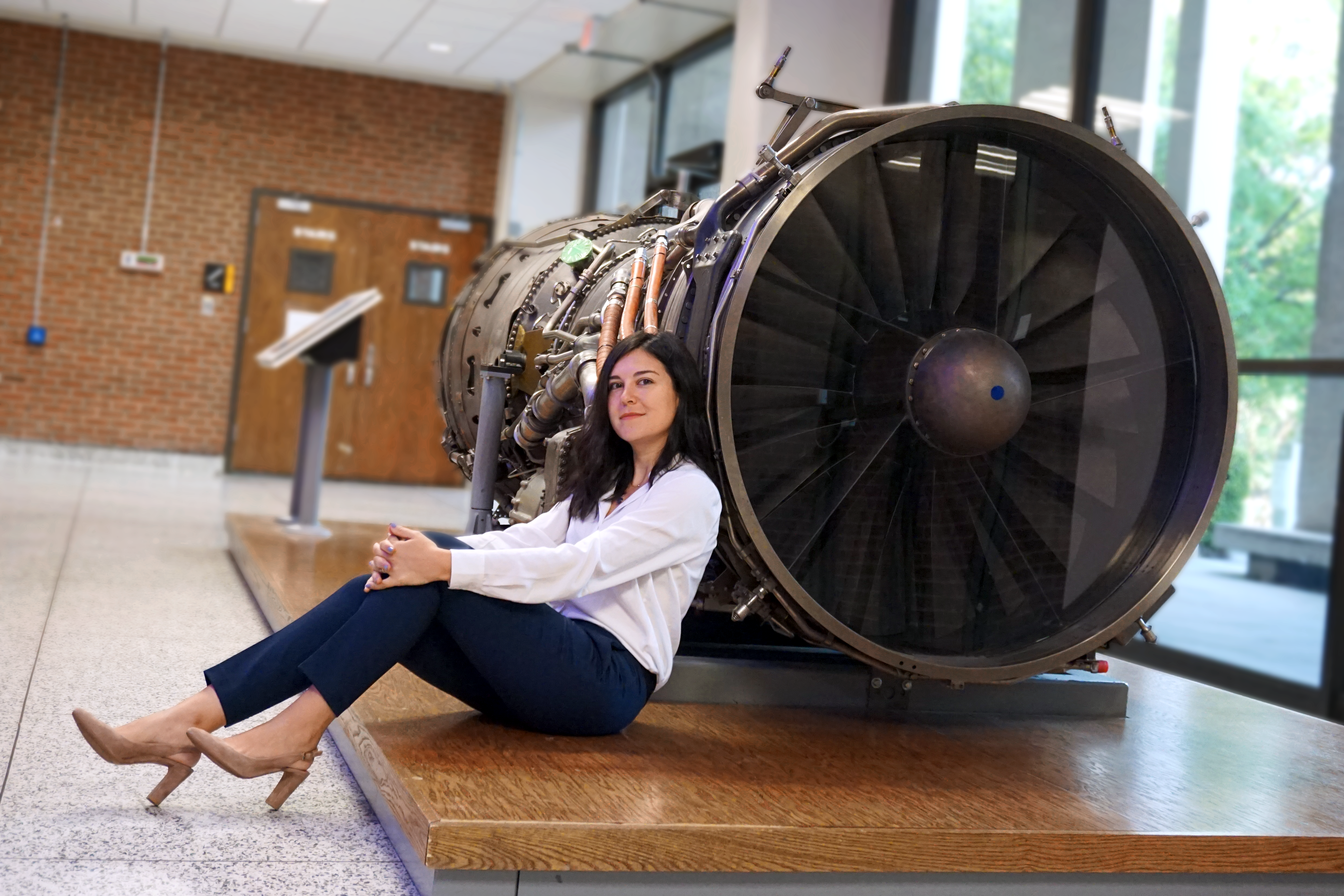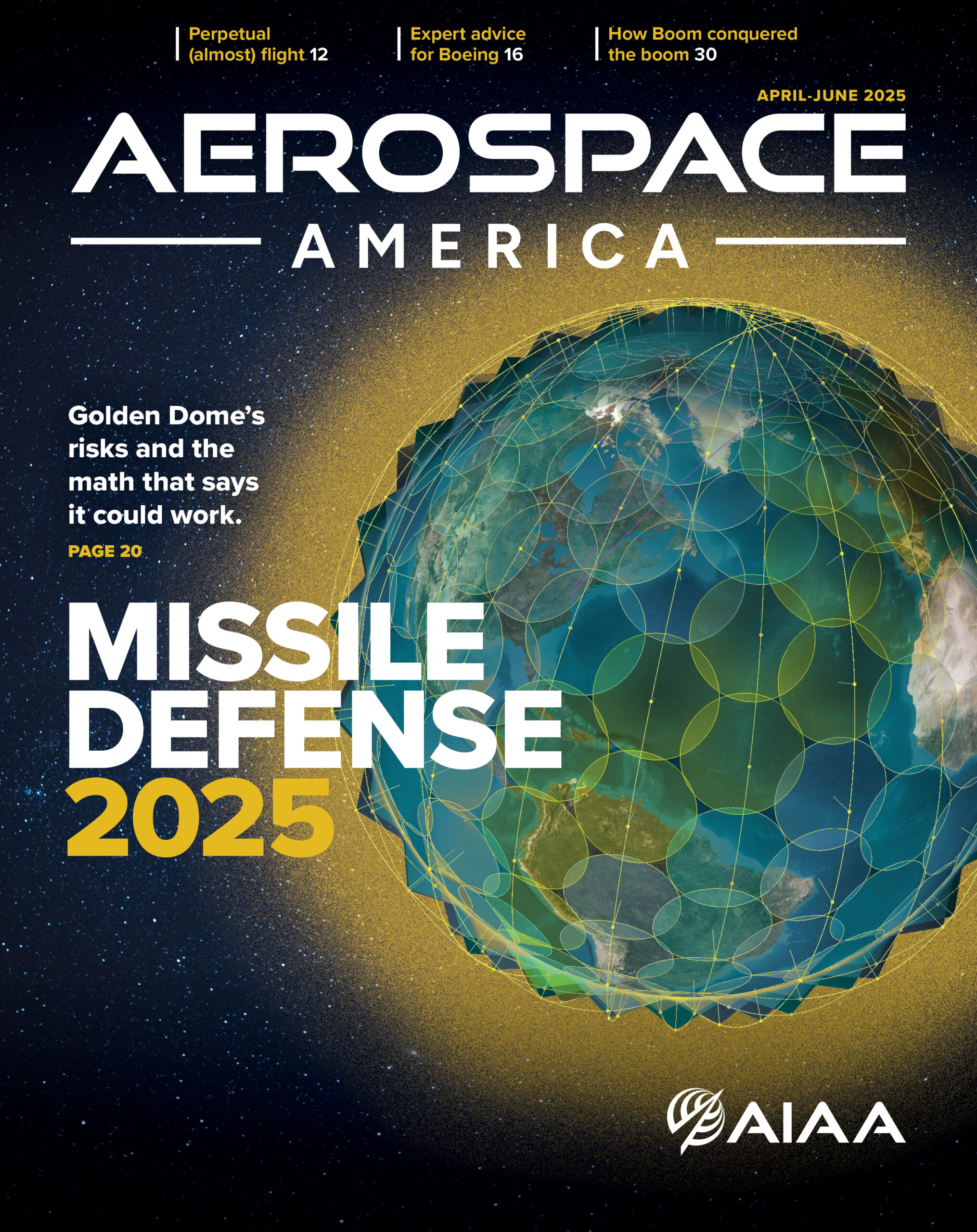Each year, AIAA presents the Lawrence Sperry Award to recognize a notable contribution made by a young professional, age 35 or under, to the advancement of aeronautics or astronautics. AIAA Senior Member Gökçin Çınar has been honored “for pioneering research and innovative contributions to electrified aircraft systems and sustainable aviation.”
As noted in her award nomination, Çınar, an Assistant Professor of Aerospace Engineering at the University of Michigan, stands as a beacon of innovation and commitment in the realm of sustainable aviation and electrified aircraft propulsion. Her Ph.D. thesis is one of the inaugural works devoted to formulating a comprehensive methodology for hybrid-electric aircraft systems design and optimization. She has made significant contributions to the integration of energy management optimization for hybrid propulsion systems at the aircraft design stage that carved a distinctive niche in the academic and professional sphere. In addition, Çınar’s innovative approach led to the creation of a unique co-design and optimization framework for aircraft sizing under diverse power management strategies, maximizing the environmental advantages of hybrid-electric aircraft.
A Fascination with Flight and Computers Led Her to Aerospace
Çınar has always been fascinated by how things work. “My dad and both grandfathers could build or fix anything, and I grew up watching them work on DIY projects. By the time I was four, I had my own little hammer and built my first airplane—two wooden sticks nailed together for the body and wings, with an old drawer pull acting as a propeller. I developed an obsession with flight; I’d watch airplanes and wonder why they looked the way they did and how they stayed in the air. There was something magical about flying. And that sense of curiosity and fascination never went away.”
Her fascination with computers also began at a young age when she began coding, experimenting with simple programs, and figuring out how computers could simulate, calculate, and solve problems that seemed impossible by hand. That passion continued to grow.
Çınar scored high enough on the national college entrance exam to choose any field of study. She noted, “aerospace engineering wasn’t a common choice at the time, and people thought I was making a mistake by selecting it—back then, nothing major was happening in aerospace in Türkiye. But I had no doubts.” Her choice, Middle East Technical University (METU), had a very strong aerospace program, and allowed her to work on cutting-edge aviation challenges. She added, “the field has since exploded in Türkiye, and aerospace engineering is now one of the most sought-after disciplines.”
Çınar chose an academic research internship early on. “My cousin, who was doing a Ph.D. in physics at the time, encouraged me to apply to the Radio and Plasma Wave Group at the University of Iowa, led by the late Prof. Donald A. Gurnett. I spent the summer analyzing whistler mode emissions in Saturn’s magnetosphere using data from the Cassini spacecraft. It was my first exposure to research methodologies and data processing, and I realized I loved tackling open-ended problems.” She later interned at Turkish Aerospace Industries, where she developed an aircraft design tool for UAVs.
She had an amazing opportunity as a freshman to join the METU Paragliding Society and learn solo paragliding, deepening her appreciation for flight. Çınar also participated in student design competitions, such as AIAA Design/Build/Fly in her junior year. In her senior year, she led the METU group in a joint METU-Georgia Tech team for the AHS/Industry Student Design Competition, where they designed a Rotary Wing Pylon Racer and won first place. “That experience, combined with my growing interest in aircraft design, led me to Georgia Tech’s Aerospace Systems Design Laboratory (ASDL) for my graduate studies.”
Rethinking the Traditional and Exploring Unconventional Propulsion Architectures
NASA programs have played a major role in shaping Çınar’s research career. While pursuing her M.S. in Aerospace Engineering, she worked on the NASA Environmentally Responsible Aviation (ERA) project, which focused on developing integrated technologies to improve efficiency and reduce noise for future air vehicles. She said, “My contributions were in fleet-level analyses, evaluating how novel technologies could impact aviation at a broader operational scale. While electrification wasn’t a focus at the time, this project sparked my interest in rethinking traditional design trade-offs and exploring how unconventional propulsion architectures could unlock new levels of efficiency and performance.”
By the time she started her Ph.D. at Georgia Tech, electrified aircraft propulsion was still a niche topic in aerospace. She turned to electric vehicle (EV) research to build a foundation in component modeling and powertrain optimization. Çınar’s dissertation was one of the first (if not the first) to develop a comprehensive methodology for electrified propulsion aircraft sizing and synthesis, introducing a propulsion-system-agnostic aircraft design and optimization framework. In addition, a major outcome of her Ph.D. was the computational aircraft design software she developed, which became a key enabler for system-level design and assessment of electrified aircraft. “This tool allowed us to analyze novel propulsion architectures, optimize their performance, and integrate power and energy management strategies into the aircraft design process—a crucial factor for hybrid systems. I feel fortunate to have worked on the right problem at the right time, creating methodologies that have since been widely adopted in our research community.”
After completing her Ph.D., she worked as a Research Engineer at ASDL, leading research groups focused on electrified aviation. Electrification became a major research priority in aerospace, and Çınar became involved early in the NASA Electrified Powertrain Flight Demonstration (EPFD) project. “Contributing to this landmark initiative has been a defining moment in my career, and I’m fortunate to be continuing this work now at Michigan,” leading the IDEAS Lab, where computational methods for future aircraft design and system-level optimization, combining physics-based modeling, data-driven approaches, and systems engineering, are developed. As part of the project, the lab developed FAST (Future Aircraft Sizing Tool), an open-source, multi-fidelity framework that enables users—from students to industry professionals—to explore and design novel aircraft. Çınar noted, “By making FAST open-source, we aimed to lower the barrier to entry for aircraft design and foster broader engagement in the field. While FAST provides a strong foundation for early-stage design and analysis, our lab also develops more sophisticated, high-fidelity methods for detailed system modeling and optimization. Building on this open-science initiative, we have since released FAST AEROBASE, a comprehensive aircraft and engine database, along with regression models to enhance predictive capabilities.”
Çınar’s team recently was selected for NASA’s AACES 2050 initiative, a multidisciplinary effort focused on evaluating next-generation aircraft configurations. Collaborating with Electra.aero and other industry and academic partners, they assess future aircraft concepts, propulsion architectures, and operational strategies for mid-century commercial aviation. “Being part of this initiative allows us to apply our expertise in system-level design and optimization, ensuring that emerging propulsion technologies and novel configurations are evaluated with a holistic, fleet-level perspective.”
Aviation at a Turning Point
“For decades, aircraft design has advanced through incremental improvements, but now, emerging technologies are redefining what’s possible. These breakthroughs aren’t just about improving efficiency—they’re expanding the design space and unlocking new levels of performance that were previously out of reach,” expressed Çınar. “With innovations in propulsion, airframe design, and computational tools, we can now optimize aircraft beyond traditional trade-offs, leading to higher efficiency, greater operational flexibility, and enhanced overall capability.”
She is most excited about how computational methods are evolving to match this complexity. “As aircraft architectures become more advanced—whether through electrification or other novel propulsion concepts—traditional design approaches alone aren’t enough. We need more sophisticated modeling, optimization, and simulation techniques to fully understand system-level trade-offs and push the boundaries of performance.”
She also noted, “At the core of all this is systems thinking. New technologies don’t exist in isolation—their real impact depends on how they interact across an entire aircraft system. That’s why a key focus of my work is developing computational methods that incorporate systems-level insights to solve complex design challenges. I’m working on a range of future aircraft technologies, exploring how novel propulsion concepts, subsystem-level solutions, and unconventional configurations can be integrated into next-generation designs. By developing new frameworks and methodologies, I aim to quantify trade-offs, assess emerging technologies in a system-wide context, and optimize aircraft design across multiple dimensions. It’s an exciting challenge, and I look forward to seeing how these advancements shape the future of aviation.”
Gaining Valuable Insights from Mentors
Çınar’s career has been shaped by many mentors and collaborators. “At ASDL, I had the privilege of collaborating with brilliant researchers, gaining valuable insights and perspectives. My Ph.D. advisor and mentor, Dr. Dimitri Mavris, had a profound impact on me. He runs one of the most influential aerospace research programs in academia, and I was lucky to have his support throughout and after my Ph.D. I learned a great deal from him about hard work, resilience, and compassion—qualities that continue to shape my approach to my work.”
She added, “NASA Aeronautics also had a major impact on my research journey. I’m grateful for the many projects I’ve worked on that were funded by NASA and for the people I’ve collaborated with along the way. These opportunities not only allowed me to contribute to high-impact research, but they also broadened my vision of what’s possible in aerospace. Gaudy Bezos-O’Connor has been an outstanding leader in the EPFD Project, and I’ve learned a great deal from working with her. Another great collaborator from EPFD is Ralph Jansen, who stands out as one of the most technically impressive engineers I’ve had the chance to work with.”
“Dr. Susan Ying’s mentorship has been invaluable since the early days of my career—I’m inspired not only by her career path but also by her generosity in sharing her experiences with me. Looking back even further, Dr. Ilkay Yavrucuk and my cousin, Dr. Tuna Yıldırım, played a pivotal role in encouraging me to pursue my Ph.D. at Michigan; Dr. Joaquim Martins has been an incredible colleague and mentor. He is a globally recognized leader in his field, yet remains humble and generous with his guidance—something I deeply admire.”
She expressed there were many others who have influenced her career, and that she’s had the privilege of working with outstanding colleagues across industry, government, and top institutions, as well as mentoring talented Ph.D. students at Georgia Tech and Michigan. “This recognition reflects our shared commitment to innovation and collaboration.” Çınar also acknowledged her family as her greatest source of support and inspiration. “Their unwavering encouragement has played a huge role in my journey, and I’m incredibly grateful for their belief in me every step of the way.”
AIAA Facilitates Connections and Broadens Perspectives and Impacts
Çınar became an AIAA member as a graduate student in 2012, recognizing the Institute as a cornerstone for aerospace research and professional development. “Over the years, AIAA has been instrumental in facilitating connections with academia, industry, and governmental bodies.”
She noted, “My involvement with AIAA has played a major role in my career. I became involved in technical committee work during the final year of my Ph.D., joining the Aircraft Electric Propulsion and Power Working Group in 2018. That group evolved into the Electrified Aircraft Technology Technical Committee (EATTC) in 2020, and I’ve been actively involved since its founding, including servicing as TC chair. I initially served as the Publications and Policy Subcommittee Chair, working with colleagues to produce Year in Review articles and contribute to AIAA’s knowledge-sharing efforts.” She is proud of the EATTC’s activities, organizing technical sessions at AIAA forums and bringing together experts from industry, academia, and government to discuss the future of electrified aviation.
Çınar has also been deeply involved in the AIAA/IEEE Electric Aircraft Technologies Symposium (EATS) since 2018, and it has become the go-to event for those working in electrified aviation, connecting aerospace and electrical engineers to exchange insights and tackle the challenges of electrified aircraft systems.
She concluded, “AIAA has broadened my network, my perspective, and my impact. Through my work in technical committees, conferences, and working groups, I’ve had the opportunity to collaborate with leading researchers, engineers, and decision makers who are shaping the future of aerospace. It’s been a privilege to contribute, and I look forward to continuing to engage with the AIAA community.”




